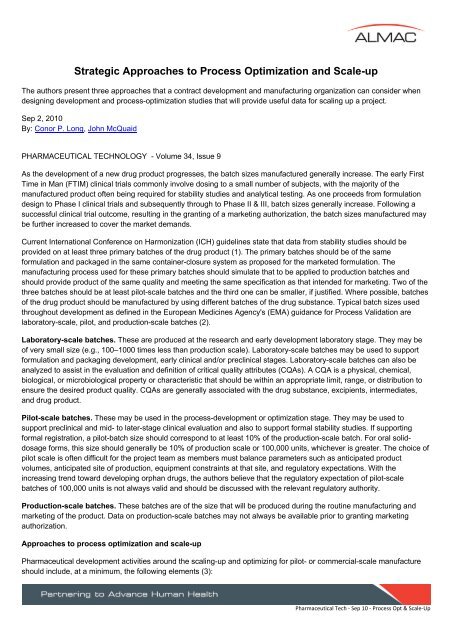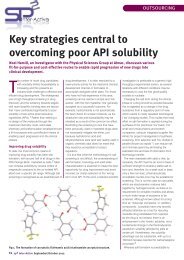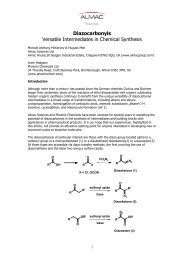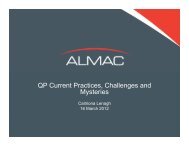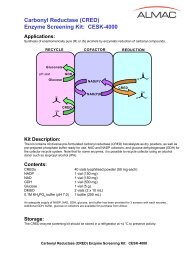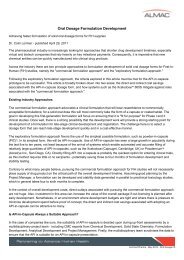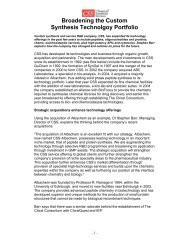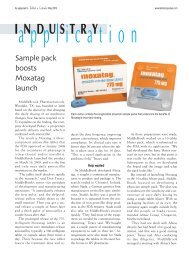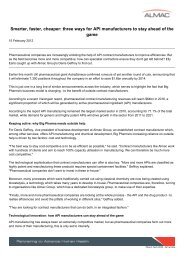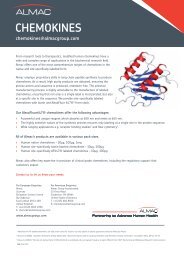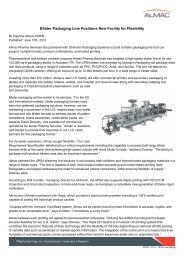Strategic Approaches to Process Optimization and Scale-up - Almac
Strategic Approaches to Process Optimization and Scale-up - Almac
Strategic Approaches to Process Optimization and Scale-up - Almac
Create successful ePaper yourself
Turn your PDF publications into a flip-book with our unique Google optimized e-Paper software.
<strong>Strategic</strong> <strong>Approaches</strong> <strong>to</strong> <strong>Process</strong> <strong>Optimization</strong> <strong>and</strong> <strong>Scale</strong>-<strong>up</strong>The authors present three approaches that a contract development <strong>and</strong> manufacturing organization can consider whendesigning development <strong>and</strong> process-optimization studies that will provide useful data for scaling <strong>up</strong> a project.Sep 2, 2010By: Conor P. Long, John McQuaidPHARMACEUTICAL TECHNOLOGY - Volume 34, Issue 9As the development of a new drug product progresses, the batch sizes manufactured generally increase. The early FirstTime in Man (FTIM) clinical trials commonly involve dosing <strong>to</strong> a small number of subjects, with the majority of themanufactured product often being required for stability studies <strong>and</strong> analytical testing. As one proceeds from formulationdesign <strong>to</strong> Phase I clinical trials <strong>and</strong> subsequently through <strong>to</strong> Phase II & III, batch sizes generally increase. Following asuccessful clinical trial outcome, resulting in the granting of a marketing authorization, the batch sizes manufactured maybe further increased <strong>to</strong> cover the market dem<strong>and</strong>s.Current International Conference on Harmonization (ICH) guidelines state that data from stability studies should beprovided on at least three primary batches of the drug product (1). The primary batches should be of the sameformulation <strong>and</strong> packaged in the same container-closure system as proposed for the marketed formulation. Themanufacturing process used for these primary batches should simulate that <strong>to</strong> be applied <strong>to</strong> production batches <strong>and</strong>should provide product of the same quality <strong>and</strong> meeting the same specification as that intended for marketing. Two of thethree batches should be at least pilot-scale batches <strong>and</strong> the third one can be smaller, if justified. Where possible, batchesof the drug product should be manufactured by using different batches of the drug substance. Typical batch sizes usedthroughout development as defined in the European Medicines Agency's (EMA) guidance for <strong>Process</strong> Validation arelabora<strong>to</strong>ry-scale, pilot, <strong>and</strong> production-scale batches (2).Labora<strong>to</strong>ry-scale batches. These are produced at the research <strong>and</strong> early development labora<strong>to</strong>ry stage. They may beof very small size (e.g., 100–1000 times less than production scale). Labora<strong>to</strong>ry-scale batches may be used <strong>to</strong> s<strong>up</strong>portformulation <strong>and</strong> packaging development, early clinical <strong>and</strong>/or preclinical stages. Labora<strong>to</strong>ry-scale batches can also beanalyzed <strong>to</strong> assist in the evaluation <strong>and</strong> definition of critical quality attributes (CQAs). A CQA is a physical, chemical,biological, or microbiological property or characteristic that should be within an appropriate limit, range, or distribution <strong>to</strong>ensure the desired product quality. CQAs are generally associated with the drug substance, excipients, intermediates,<strong>and</strong> drug product.Pilot-scale batches. These may be used in the process-development or optimization stage. They may be used <strong>to</strong>s<strong>up</strong>port preclinical <strong>and</strong> mid- <strong>to</strong> later-stage clinical evaluation <strong>and</strong> also <strong>to</strong> s<strong>up</strong>port formal stability studies. If s<strong>up</strong>portingformal registration, a pilot-batch size should correspond <strong>to</strong> at least 10% of the production-scale batch. For oral soliddosageforms, this size should generally be 10% of production scale or 100,000 units, whichever is greater. The choice ofpilot scale is often difficult for the project team as members must balance parameters such as anticipated productvolumes, anticipated site of production, equipment constraints at that site, <strong>and</strong> regula<strong>to</strong>ry expectations. With theincreasing trend <strong>to</strong>ward developing orphan drugs, the authors believe that the regula<strong>to</strong>ry expectation of pilot-scalebatches of 100,000 units is not always valid <strong>and</strong> should be discussed with the relevant regula<strong>to</strong>ry authority.Production-scale batches. These batches are of the size that will be produced during the routine manufacturing <strong>and</strong>marketing of the product. Data on production-scale batches may not always be available prior <strong>to</strong> granting marketingauthorization.<strong>Approaches</strong> <strong>to</strong> process optimization <strong>and</strong> scale-<strong>up</strong>Pharmaceutical development activities around the scaling-<strong>up</strong> <strong>and</strong> optimizing for pilot- or commercial-scale manufactureshould include, at a minimum, the following elements (3):Pharmaceutical Tech ‐ Sep 10 ‐ <strong>Process</strong> Opt & <strong>Scale</strong>‐Up
• Defining the target product profile as it relates <strong>to</strong> quality, safety <strong>and</strong> efficacy, considering, for example, the routeof administration, dosage form, bioavailability, dosage, <strong>and</strong> stability• Identifying CQAs of the drug product, so that those product characteristics having an impact on product qualitycan be studied <strong>and</strong> controlled• Determining the quality attributes of the drug substance <strong>and</strong> excipients, <strong>and</strong> selecting the type <strong>and</strong> amount ofexcipients <strong>to</strong> deliver drug product of the desired quality <strong>and</strong> efficacy• Selecting an appropriate manufacturing process• Where possible, identifying a control strategy.The basis of quality-by-design (QbD) follows that well-designed experiments, carefully planned <strong>and</strong> thought out from theoutset of formulation development, can produce quality data from an early stage, which can minimize lengthy <strong>and</strong> costlyrepetition of manufacturing <strong>and</strong> subsequent studies <strong>and</strong> analysis. Nevertheless, before manufacturing registrationbatches, it is usual <strong>to</strong> invest additional time <strong>and</strong> effort in challenging, <strong>and</strong>, where necessary, optimizing the existingmanufacturing process. This is achieved by making additional development batches at labora<strong>to</strong>ry-scale, pilot scale, <strong>and</strong>possibly even at production scale. The output from the above development efforts provides the basis for justification thatscale <strong>up</strong> can be achieved without a consequent loss in quality <strong>and</strong>/or efficacy <strong>and</strong> provides the link between formulation<strong>and</strong> process development, pilot-scale manufacture, <strong>and</strong> eventual commercial production.Analysis of the data assists in determining the parameters that have a known effect <strong>up</strong>on a CQA of the drug product.These parameters are referred <strong>to</strong> as being critical process parameters (CPPs). Furthermore, data obtained creates apicture of the product <strong>and</strong> process, how its design has evolved, what is critical <strong>and</strong> must be controlled, <strong>and</strong> provenacceptable ranges (PARs) around specific process parameters.This article presents three approaches that a CDMO can consider in designing development <strong>and</strong> process optimizationstudies that will provide useful data on scaling <strong>up</strong> a product.Approach 1: Quality ensured by end-product testingThis method of manufacturing is a minimal approach <strong>to</strong> the mechanistic underst<strong>and</strong>ing of a process. The development ismainly empirical with research often conducted one fac<strong>to</strong>r at a time (OFAT). Following manufacture, there would be littleor no 'design space' defined, resulting in a strict manufacturing process that should be adhered <strong>to</strong> in order <strong>to</strong> minimizeany variability in product characteristics <strong>and</strong> thus the CQA profile. Validation will primarily be based on initial full-scalebatches. CPPs are determined using only prior knowledge. Proven acceptable ranges for CPPs are not fully determined.A minimal knowledge of PARs is determined. The following is an example of how this approach is used in developing afilm-coated tablet.Example 1: Blend, direct compression, <strong>and</strong> coating scale-<strong>up</strong> operation. A blending operation at a specified scale isperformed using a st<strong>and</strong>ard tumble blender. The drive unit is set <strong>to</strong> a fixed speed. The excipients are added <strong>to</strong> theblending shell <strong>and</strong> tumbling is initiated. The blend is mixed for a set period of time. Following this mixing time, the blend issampled <strong>to</strong> determine blend uniformity <strong>and</strong> bulk assay values. If the blend is determined <strong>to</strong> be uniform, the time <strong>and</strong>speed used is recorded <strong>and</strong> would be used for future batches. If the blend is found <strong>to</strong> be nonuniform at this stage, anadditional mixing period is used, followed by further sampling for uniformity <strong>and</strong> bulk assay. This procedure is repeateduntil uniformity is achieved with the mixing time <strong>and</strong> speed recorded for future batches.The uniform blend is compressed using a suitable tablet press for the batch size in question. The compressionparameters are adjusted in order <strong>to</strong> obtain the desired product characteristics such as tablet weight, hardness, thickness,disintegration time, <strong>and</strong> dissolution time. Compression force <strong>and</strong> compression speed would be adjusted during set-<strong>up</strong>s<strong>and</strong> continually assessed with appropriate adjustments made. Intensive in process checks continuously moni<strong>to</strong>r productquality characteristics in order <strong>to</strong> maintain an acceptable product.Pharmaceutical Tech ‐ Sep 10 ‐ <strong>Process</strong> Opt & <strong>Scale</strong>‐Up
The tablet cores are progressed for coating using a batch coating process. The coating parameters are initially set usingprior knowledge of the equipment being used <strong>and</strong> coating at a particular batch size. Intensive in-process checks, inaddition <strong>to</strong> close visual observations by trained opera<strong>to</strong>rs, allow adjustments <strong>to</strong> be made throughout the coating process.The final parameters would be recorded <strong>and</strong> used for future coating operations at this scale.With the advent of the guideline ICH Q8 Pharmaceutical Development, this his<strong>to</strong>rical approach is falling out of favor, <strong>and</strong>would likely invite greater scrutiny from regula<strong>to</strong>ry authorities following submission (3).Approach 2: Full design of experimentsAn enhanced QbD approach <strong>to</strong> product development would additionally include a systematic evaluation, underst<strong>and</strong>ing,<strong>and</strong> refining of the formulation <strong>and</strong> manufacturing process, including (3):• Identifying–using prior knowledge, experimentation, <strong>and</strong> risk assessment–the material attributes <strong>and</strong> processparameters that can have an effect on product CQAs• Determining the functional relationships that link material attributes <strong>and</strong> process parameters <strong>to</strong> product CQAs• Using the enhanced process underst<strong>and</strong>ing in combination with quality risk management <strong>to</strong> establish anappropriate control strategy that can, for example, include a proposal for design space(s) <strong>and</strong>/or real-timerelease.Figure 1: An Ishikawa (fishbone) diagramthat identifies all potential parameters thatcan have an impact on the desired qualityattribute. (ALL FIGURES COURTESY OFTHE AUTHORS)higher level of process underst<strong>and</strong>ing.Risk-assessment <strong>to</strong>ols can be used <strong>to</strong> identify <strong>and</strong> rank potential parameters deemed<strong>to</strong> have an impact on product quality based on prior knowledge <strong>and</strong> initial experimentaldata. The initial list of all possible parameters can be quite extensive, but is likely <strong>to</strong> benarrowed, as process underst<strong>and</strong>ing is increased, <strong>to</strong> a smaller list of potentialparameters. Narrowing the list has the advantage of reducing the number ofexperiments necessary in the modeling of a design space. The list can be refinedfurther through screening experimentation <strong>to</strong> determine the significance of individualparameters <strong>and</strong> potential interactions. Once the significant parameters are identified,they can be further studied (e.g., through a combination of design of experiments,mathematical models, or studies that lead <strong>to</strong> mechanistic underst<strong>and</strong>ing) <strong>to</strong> achieve aExample 2: Full design of experiments. Using prior scientific knowledge, the projectteam experts will use the target product profile <strong>to</strong> establish CQAs, <strong>and</strong>, in turn, CPPs.An approach could follow the five steps listed below.Step 1: Cause <strong>and</strong> effect analysis (Ishikawadiagram). The expert team compiles a cause <strong>and</strong>effect (C&E) diagram, also known as an Ishikawadiagram, that maps out all potential parameters in aTable I: The potential parameters in anexample analysis.Figure 2: Example C&E diagram detailingmanufacturing process. The number of parameters can be very extensive. An exampledry-mixing <strong>and</strong> granulation parameters. analysis performed for a recent project at <strong>Almac</strong> resulted in 79 parameters, possiblyinfluencing the final tablet quality (see Figure 1). The parameters determined areshown in Table I. Figure 2 shows the potential CPPs making <strong>up</strong> the dry granulation step of the manufacturing process.Pharmaceutical Tech ‐ Sep 10 ‐ <strong>Process</strong> Opt & <strong>Scale</strong>‐Up
Step 2: Ranking of process parameters in order of importance. The list wasanalyzed using a risk-assessment approach <strong>to</strong> prioritize the parameters. Parametersgraded as high risk were progressed for investigation. An example parameter ratingform is presented in Figure 3. The example shows a parameter rating form focusing onthe nine parameters from the dry-granulation stage that may have an effect on theCQAs. A separate rating form would be completed for each stage of the manufacturingprocess. A scoring system, ranging from 1 being minimal effect, 3 being moderate,<strong>and</strong> 9 having a major effect on product attributes, was used. This scoring approachapplies a much greater weighting <strong>to</strong> parameters deemed <strong>to</strong> impact a product'sattributes significantly, thus increasing the necessity <strong>to</strong> further study the effect of theparticular variable.Figure 4: Example results parameterrating form.Figure 4 shows an example of results following the compilation of the scoring process.The example illustrated focuses on a single product attribute (tablet hardness) <strong>and</strong> asingle processing step (dry granulation). The full exercise produces individual tablescompiling project team views regarding each processing parameter in relation <strong>to</strong> eachCQA.Figure 5 shows how decisions can be made onwhich parameters may be investigated at the nextstage. The <strong>to</strong>tal score is the sum of the scoresobtained for process parameters across all theCQAs. This will provide a rank order of parametersthat may have an effect on CQAs. Using prior experience co<strong>up</strong>led with knowledge ofthe intended process, the number of parameters can be minimized. The number ofparameters investigated using experimental design will significantly increase thenumber of batches required.Figure 6: Detail of parameter riskassessment.Step 3: Assessing the impact of parameters on the product. The parameters werefurther screened by considering the higher ranked parameters in each processing stepas having a high influence on each CQA. Also, every parameter having a score of 40or more was classified as having a high influence on CQAs. An example matrixshowing the impact assessment for the drygranulation step is presented in Figure 6.Step 4: Determine the parameters <strong>to</strong> beinvestigated experimentally. Following a full analysis using prior knowledge <strong>and</strong>experience of the formulation <strong>and</strong> the manufacturing techniques, conclusions will bedrawn from the risk-based classification process <strong>to</strong> list the parameters <strong>to</strong> beinvestigated using a first-screening experimental design (see Table II).The parameters were investigated using a 2-level screening design of experiments. Inthis example, 10 parameters were chosen <strong>to</strong> be screened.Figure 3: Example parameter rating form.Figure 5: Parameter evalution <strong>to</strong>determine which parameters should beinvestigated.Table II: Parameters <strong>to</strong> be investigated inexample analysis.Figure 7: The relationship between thenumber of parameters <strong>and</strong> resolution ofdesign <strong>to</strong> the number of experimentsrequired.The number of parameters, in addition <strong>to</strong> the desired resolution of the design, impactson the number of experiments required in determining the critical parameters. Figure 7shows the relationship between number of parameters <strong>and</strong> resolution with number ofexperiments required. Additional considerations such as time <strong>and</strong> activepharmaceutical ingredient constraints may also influence the number of experimentsthat are possible at this stage.Pharmaceutical Tech ‐ Sep 10 ‐ <strong>Process</strong> Opt & <strong>Scale</strong>‐Up
The st<strong>and</strong>ard experimental design notation is presented in Figure 8, where X is thenumber of levels being investigated. A level is a particular parameter value. In thecase of compression speed, the two levels could be the maximum <strong>and</strong> minimum turretspeed that would potentially be used in an operation. K is the number of parametersbeing investigated. P is the degree of fractioning that is being performed in order <strong>to</strong>reduce the number of experiments. A full fac<strong>to</strong>rial design would not have a value for pdisplayed.For example, 25 would be a two-level design covering 5 parameters. This wouldrequire 32 experiments <strong>to</strong> investigate the parameter effects. 25-1 is a fractional designof this example where the number of experiments required is halved <strong>to</strong> 16. As the degree of fractioning increases thequality of information obtained from the design decreases. A typical approach would be <strong>to</strong> use a high-quality (highresolution) design for optimization <strong>and</strong> in-depth study of a process <strong>and</strong> use a low-resolution design for initial screening inorder <strong>to</strong> determine critical parameters. The design would then generate a number of experiments that detail the exactparameters <strong>to</strong> set for a manufacturing operation. Each experiment would be completed <strong>and</strong> the subsequent productattributes would be determined. Statistical software is used <strong>to</strong> analyze the effect of the process parameters on the productattributes <strong>and</strong> determine how critical each parameter is.Figure 9: The influence of granula<strong>to</strong>r finalscreen size <strong>and</strong> roller pressure on tablethardness.screen size decreases, the tablet hardness increases.In the described example, the results of the experimental design allowed the numberof potential critical parameters for the initial screening <strong>to</strong> be reduced <strong>to</strong> eight. Theseeight parameters were then investigated using a more comprehensive 3-level design.This type of design, also referred <strong>to</strong> as a response surface method (RSM), will requiremore experiments. The previous 2-level screening design is used <strong>to</strong> minimize thenumber of parameters investigated so as <strong>to</strong> minimize the number of experiments atthe 3-level design stage. In this example, the results of the 3-level design enabledstatistically significant models <strong>to</strong> be calculated showing the effects of the criticalparameters on a number of product attributes. A graphical example of a modeldisplaying the influence of granula<strong>to</strong>r final screen size <strong>and</strong> roller pressure on tablethardness is shown in Figure 9. As can be seen, as the roller pressure <strong>and</strong> granulatingStep 5: Design space. The linkage between the process inputs (input parameters <strong>and</strong> process parameters) <strong>and</strong> theCQAs can be described in the design space. The risk-assessment <strong>and</strong> process-development experiments described cannot only lead <strong>to</strong> an underst<strong>and</strong>ing of the linkage <strong>and</strong> effect of process inputs on product CQAs, but also help identify theparameters <strong>and</strong> their ranges within which consistent quality product can be achieved.Approach 3: Hybrid method combining elements of approaches 1 <strong>and</strong> 2.Figure 8: St<strong>and</strong>ard experimental designnotation.The use of a full design of experiments approach can result in a significant amount of batches being manufactured <strong>to</strong>cover the design space. As the number of batches required <strong>to</strong> describe the design space increases, the developmenttime <strong>and</strong> cost increases. A third method combining elements from approaches 1 <strong>and</strong> 2 optimizes the balance betweendevelopment time <strong>and</strong> cost <strong>and</strong> maintains a good underst<strong>and</strong>ing of the manufacturing process. This hybrid approach canbe achieved by breaking the manufacturing process in<strong>to</strong> defined sections. The initial blending step can be performedusing Approach 1. The blend could be manufactured <strong>to</strong> specification, <strong>and</strong> end-product testing will show the quality (e.g.blend uniformity/assay). Parameters such as blending time <strong>and</strong> blending speed can be determined by intensive blenduniformity <strong>and</strong> bulk-assay analysis allowing blending windows <strong>to</strong> be established. A second confirma<strong>to</strong>ry batch could bemanufactured using the parameters obtained from the initial batch that could provide additional confidence in themanufacturing process.The blend will have been shown <strong>to</strong> meet specification <strong>and</strong> can then be progressed <strong>to</strong> the next processing steps. Anexperimental design approach can then be performed. For example, the next steps could involve dry granulation followedby compression in<strong>to</strong> tablets. As described in approach 2, following completion of a full risk assessment <strong>and</strong> subsequentcause <strong>and</strong> effect diagram detailing the potential process parameters, a structured design of experiments plan can bePharmaceutical Tech ‐ Sep 10 ‐ <strong>Process</strong> Opt & <strong>Scale</strong>‐Up
devised. Rather than completing each experiment at the full scale, the experiment can be performed using a suitablysized aliquot of the blend manufactured already. As both dry granulation <strong>and</strong> compression are a continuous throughputprocess, the parameters investigated are mainly independent of batch size used. Using this approach, a 60-kg blendcould be divided in<strong>to</strong> 3-kg sublots, allowing <strong>up</strong> <strong>to</strong> 20 experiments <strong>to</strong> be run.Following completion of the experiments <strong>and</strong> analysis of the data, a confirma<strong>to</strong>ry batch could be manufactured using theoptimized parameters determined from statistical analysis <strong>and</strong> preparation of a design space. The resulting batch or tabletcores could be progressed <strong>to</strong> coating if required. Again, the coating process can be investigated using method 1 or 2.ConclusionStrategies for product development can vary from company <strong>to</strong> company <strong>and</strong> from product <strong>to</strong> product, <strong>and</strong> as such, acontract development <strong>and</strong> manufacturing organization (CDMO) must be able <strong>to</strong> provide a service that can suit therequirements of any cus<strong>to</strong>mer. For a variety of reasons, a company might choose either an empirical approach or a moresystematic approach <strong>to</strong> product development. The approaches described can aid in the provision of a high-qualitydevelopment offering from the outset while striving <strong>to</strong> control timelines <strong>and</strong> costs, which are commonly seen as opposingforces in the pharmaceutical industry.Conor P. Long* is a senior formulation development scientist <strong>and</strong> John McQuaid is a technical development manager,both at <strong>Almac</strong> Pharma Services, 22 Seagoe Industrial Estate, Craigavon, BT63 5QD, UK, tel: +44 (0) 2838 363363, fax+44 (0) 2838 363300, conor.long@almacgro<strong>up</strong>.com.*To whom all correspondence should be addressed.References1. ICH, Q1A (R2) Stability Testing of New Drug Substances <strong>and</strong> Products, (ICH, Geneva, Feb. 2003).2. EMA, Note for guidance, <strong>Process</strong> Validation, CPMP/QWP/848/96, (EMA, London, Sept. 2001).3. ICH, Q8 (R2) Pharmaceutical Development, (ICH, Geneva, Aug, 2009).Pharmaceutical Tech ‐ Sep 10 ‐ <strong>Process</strong> Opt & <strong>Scale</strong>‐Up


